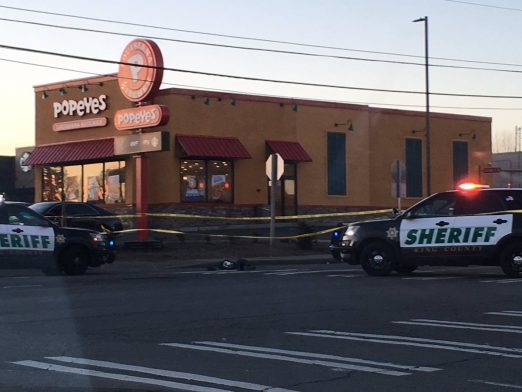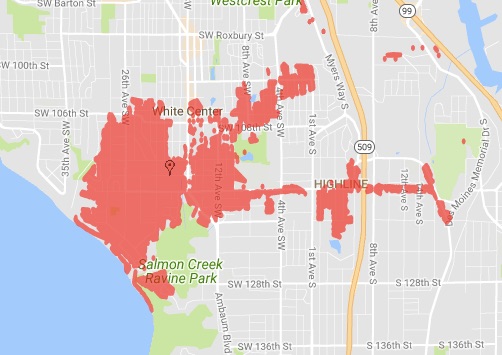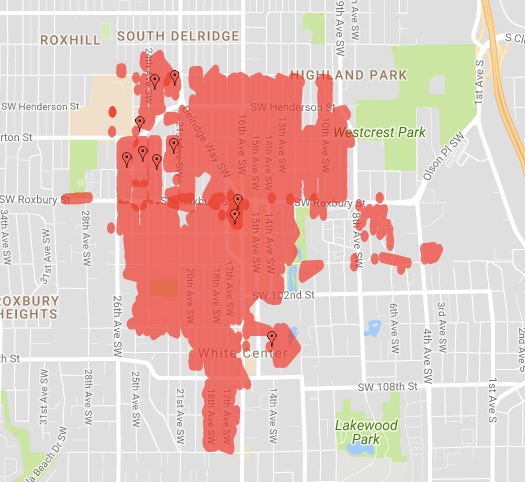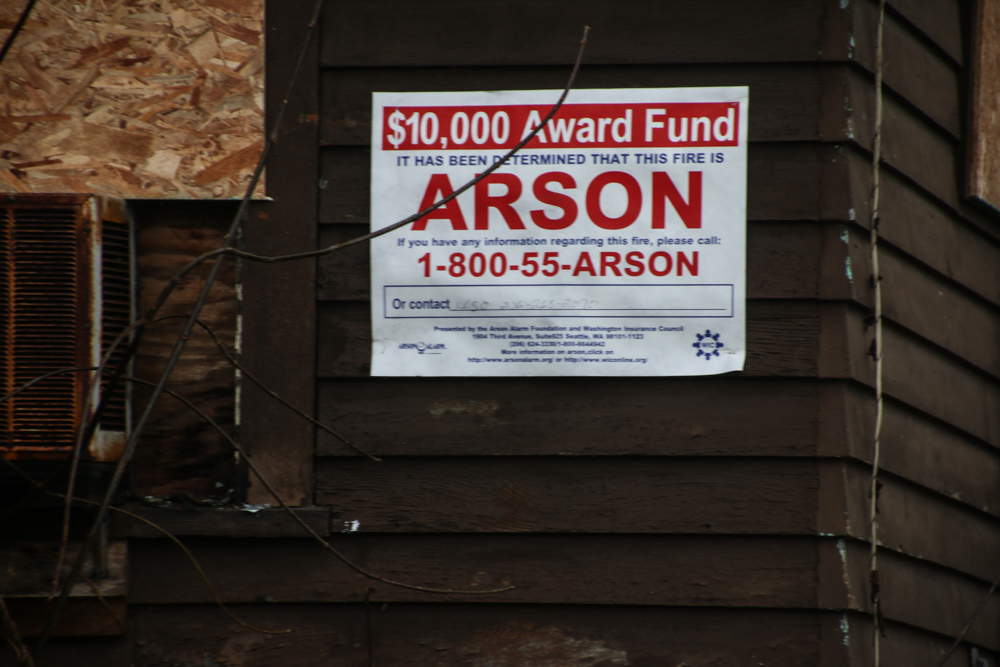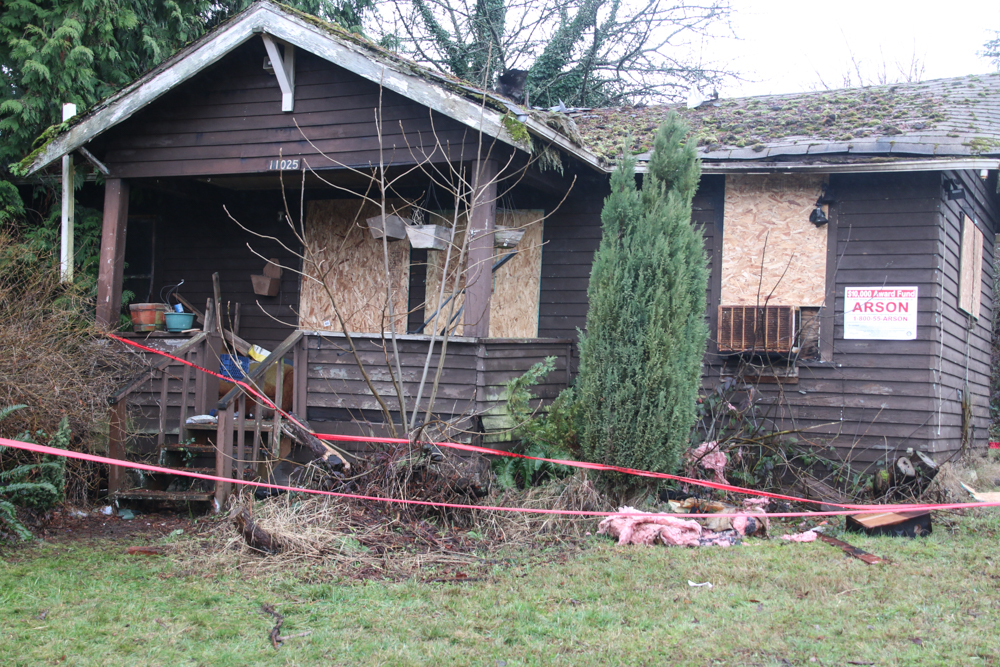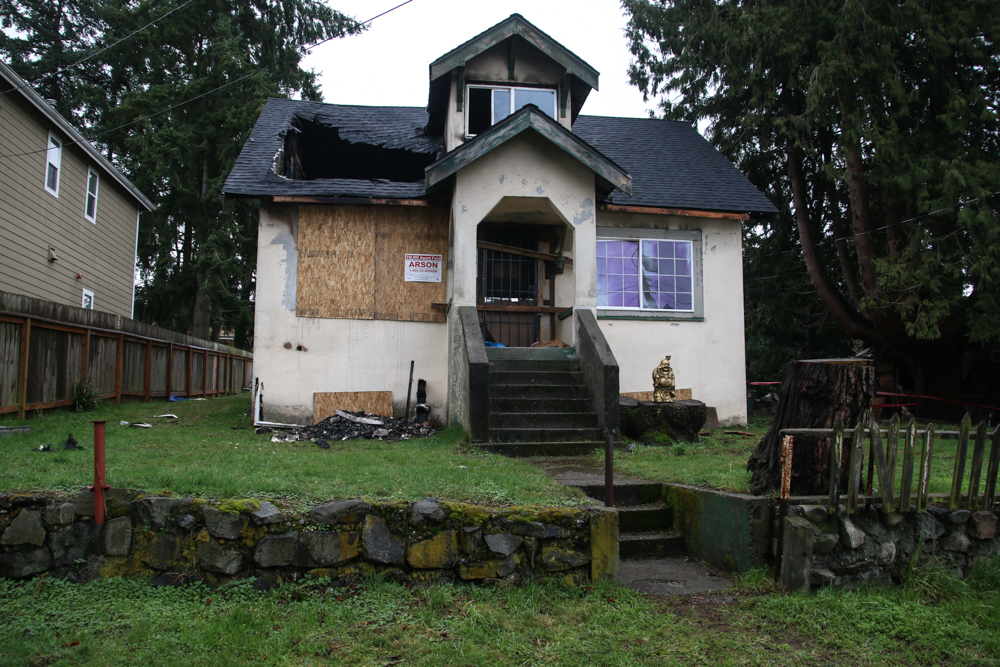By Tracy Record
White Center Now editor
Schools, trash, libraries, public safety – many services that touch most local lives were on the agenda Thursday night as the North Highline Unincorporated Area Council led its first community meeting of the year.
HIGHLINE PUBLIC SCHOOLS: Aaron Garcia from the White Center Community Development Association and Duggan Harman from the school district‘s Finance Department spoke about the February 13 levy vote.
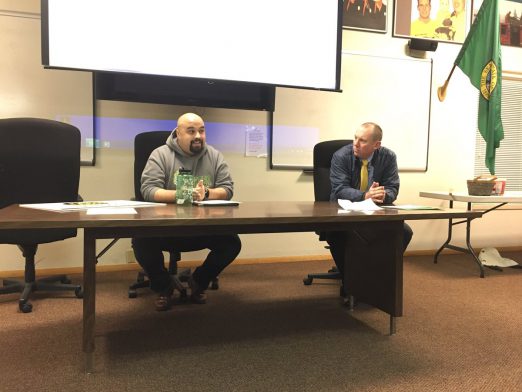
It’s a levy renewal, at a lower rate than the previous levy. They showed this video featuring a student explaining the levy:
That led to a general discussion of the state continuing to underfund public education. That’s not all directly in voters’ control – but this levy is. You’ll find more information about the levy and the voting process here. Get your ballot in by 8 pm on Election Day (February 13th) if you’re dropping it off at the White Center Library dropbox – or if you’re putting it in the mail, be certain it’ll be postmarked by that day.
KING COUNTY’S DRAFT COMPREHENSIVE SOLID WASTE MANAGEMENT PLAN: A guest from the county gave a presentation on this draft plan that’s in the middle of a two-month public-comment period. He had these stats:
-King County serves 37 cities (not Seattle and Milton)
-6 urban transfer stations (Bow Lake is the closest one)
-4 rural transfer facilities
-9 closed landfills
-1 open landfill (Cedar Hills)
He said the county is aiming for 70 percent recycling – but the current rate is only 52 percent. And that’s part of the problem leading to the impending maxing out of the Cedar Hills Landfill, which will be full by 2028 unless new capacity is developed. Three options are being addressed for that last challenge – “further develop” the landfill to extend its life to 2040, take waste by rail to another landfill outside the county, or “build a waste-to-energy facility in King County.” (Seattle already sends its trash out of the area – to an Oregon landfill.) The timeline for sorting this all out is due around year’s end, with final state approval next year. They’ve already had two public open houses about all this and there’s one more, February 7th at the King County Library Service Center in Issaquah.
An attendee asked what “waste to energy” might mean. Depends on where the plant would be built, was the reply – and the plant itself would cost more than a billion dollars to build. And even if trash were burned to generate electricity, that would leave ash that would have to be taken to a landfill somewhere. Asked how Governor Inslee’s carbon-tax proposal would affect that, the county rep said they weren’t sure yet.
You can read the draft plan (and find out more about it and the comment process) by going here.
Also – a “fix it” event is coming up in White Center, 9:30 am-12:30 pm March 24th – find out more about that here.
METRO TRANSIT POLICE: Resource Officer Deputy Michael Martinez says he’s “in White Center all the time” as part of the job. He came with several concerns – including the 15th/Roxbury bus stop’s ongoing troubles, and planning for the Route 120 conversion to the RapidRide H Line. The route’s “pretty much going to stay the same in White Center,” with four fewer stops, he said. 15th/107th, 100th/15th, Roxbury/15th, 20th/Roxbury are the stops that’ll be in White Center, and the others will be removed, he said. Construction will start toward year’s end and continue through next year, for the route to be launched in 2020. He said that Metro plans to do what it can to minimize impacts on parking – just a handful of spots will be affected. They’re hoping to put in a crosswalk at 15th/107th (to/from the library). The stairs near Greenbridge will be better-illuminated. He stressed that the county wants to hear any concerns at this stage of planning.
Asked about the 15th/Roxbury bus stop and its challenged, Deputy Martinez said there are plans for cameras and lightning at the shelters in the area.
He also reminded everyone that Transit Police has only about 76 officers for the entire county – no more than six on any given shift. Two of them cover “from Roxbury to Federal Way.” They check the trouble spots, like 15th/Roxbury, several times a shift – but “as is the nature of police work,” they’re not always in the right place at the right time. Things have been “a little better lately” (not counting the 16th SW double murder, which was not at/near a transit stop), he said. He promised monthly updates.
ALSO FROM THE SHERIFF’S OFFICE: Captain Rick Bridges, operations captain for Precinct 4 (which includes unincorporated North Highline), introduced himself. He’s been with KCSO for 19 years and says he’s on his “fourth tour” of this precinct. Lots of change as Sheriff Mitzi Johanknecht gets her staff in place – former TV reporter Liz Rocca is her new chief of staff – he said. (william.bridges@kingcounty.gov)
LIBRARY UPDATES: NHUAC heard from King County Library System‘s regional manager Angie Benedetti (whose jurisdiction includes WC, Greenbridge, and Boulevard Park), community conduct coordinator Melissa Munn (whose responsibilities includes security and patron behavior issues), and facilities-design coordinator Adrianne Ralph.
First, they brought an update on the “jewel,” the almost-two-years-old White Center Library. It’s increased circulation and usage, she said. About the recent vandalism, she said the branch has had seven different incidents of window damage since the library opened – from a dog scratching on the window to the November 10th incident that led to six windows being damaged. Total repair costs for all incidents is $42,000. Insurance covered some of that, Benedetti said, but there’s about a $10,000 threshold. She said the number includes “about $12,000 in preventive maintenance that we’ve done,” including adding film on exteriors and interiors of the windows.
A bicycle-repair center that had been installed at the library had to be removed within the first few months because the tools kept getting stolen, she said. They also, after window problems started happening, “removed every single rock on the property.” But – “that didn’t help, whoever it was that was doing it was bringing their own rocks at that point.” And she said, according to the King County Sheriff’s Office, it wasn’t just the library getting targeted – other businesses were getting hit by vandals too. Meantime, they also have a trespass agreement with KCSO so if they “see anyone around the library during closed hours” they are empowered to “move them along.” This includes signage to warn people to stay off the site.
Asked if the glass usage could be reduced – the library team said basically, no. In fact, even the old library had significant window-breakage problems, they added. And overall, the library move did not lead to a major increase in trouble. In response to a question, Benedetti also said someone was reported to have been arrested for rock-throwing, and they haven’t had a problem since that arrest. And she and her collagues noted that other areas of the county were having problems too – this isn’t just a White Center thing and isn’t just a library thing. Nonetheless, at least one attendee said she thinks the community should get more information about these problems, more often.
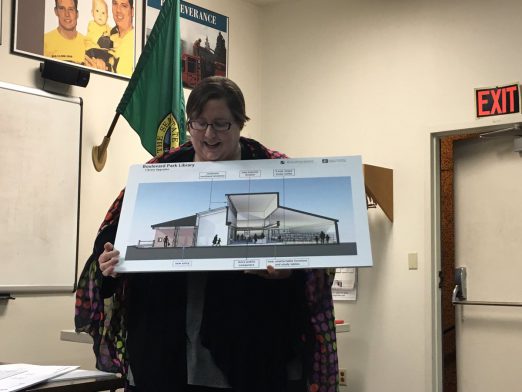
The Boulevard Park Library‘s interior remodel was explained – including the restrooms being moved to an area with better visibility, to try to reduce the incidence of behavioral incidents. The meeting room is being expanded; “a few more computers” are being added; new finishes; spaces for kids, a dedicated teen area, and more. Ralph said they’re going out to bid soon and hope to have bids back by April, and that “about this time next year” if all goes well, the remodel will be done.
What’ll happen during the eight-or-so-month construction closure? asked NHUAC president Liz Giba. Benedetti said that for one, they’ll be “expanding our mobile services … with materials for all ages.” They might have some kids’ programs at North SeaTac Community Center. They haven’t worked out yet what they might be able to do regarding getting computers into the community for public use.
SEOLA POND FOLLOWUP: Scott Dolfay, who spent a year planning a restoration event at this “unofficial park,” presented a video showing some of what happened on the day that dozens of local students were there to help out from Westside School and Explorer West Middle School. (Added)
He also got private and public donations and grants to help pay for the plants to add to the area, and is working on more. (Here’s some coverage from our partner site West Seattle Blog.) “This is really a special place” that can become “even more special,” Dolfay told NHUAC. He’s also looking into the possibility of introducing native turtles. He expects to be working on the pond area for years.
WHITE CENTER CHAMBER OF COMMERCE: A new effort to get it going again is under way, with the first meeting set for February 5th.
REDEVELOPMENT OF WHITE CENTER FOOD BANK/PUBLIC HEALTH SITE: Garcia said discussions are continuing on this, with the potential of affordable housing.
The North Highline Unincorporated Area Council meets first Thursdays most months, 7 pm at North Highline Fire District HQ – watch northhighlineuac.org for updates between meetings. Guests invited for upcoming meetings include KCSO Gang Detective Joe Gagliardi and the library system’s new director.
